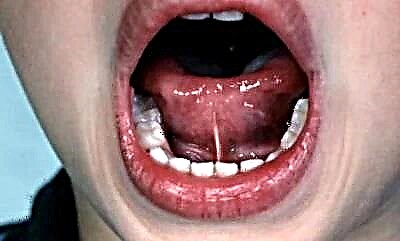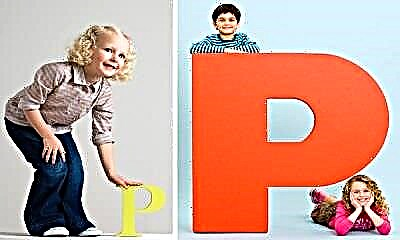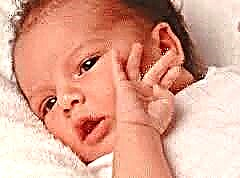
Each child develops in its own way. Someone at two years old reads poetry, and someone only by four masters the pronunciation of some sounds. Nevertheless, there are certain generally accepted norms of mastering the sounds of speech. One of the last the child has the sound "P". Under favorable conditions for the development of the baby, this happens in the fifth year of life. Some children have much earlier - at three or even two years. But still, if there is no sound in speech by the age of five, this can be considered a speech pathology.

Causes
Predisposing factors for incorrect pronunciation of "P" may be the following:
- Short hyoid frenulum. It is able to restrict the movement of the tip and the front of the back of the tongue upward.
- Insufficient air flow when pronouncing this sound.
- Limited mobility of the muscles of the tongue, which leads to the inability to take the correct articulatory position and perform arbitrary movements with the tongue.

At the beginning of work on the production of this sound, parents need to find out from a specialist whether at least one of the factors takes place in your case.
Short frenum of the tongue
If the child has a short bridle that does not require cutting, then work must be done to stretch it. It includes massage and articulatory exercises. It is quite possible to make massage at home. You need to grab the bridle with your thumb and forefinger at the very bottom under the tongue and rub with pressing movements. It is necessary to knead the bridle along its entire length, trying to stretch it. But be careful not to damage it. Make several of these movements. After a while, you will see that the bridle has enlarged.

As an example of articulation exercises for stretching the frenum, we suggest you the following:
- "Reach your tongue up to your nose." You need to smile, open your mouth. Raise the wide tip of the tongue up to the nose, and then lower it to the upper lip. In this case, the tongue should not narrow, and the jaws should remain motionless.
- "Reach for the chin." Smile and open your mouth. Try to reach your chin with your wide tongue. Make sure that the jaws are still.
- "Painter". Smile and open your mouth. Use the tip of your tongue to stroke the palate from the teeth to the throat. The lower jaw is motionless.

There are rules that parents need to remember so as not to harm their child while doing the exercises:
- You need to open your mouth as wide as possible, but at the same time the child must reach the alveoli.
- All exercises should be done slowly, close to the limit of the possible. Remember, while doing the exercises, the tongue can get tired, the bridle can start to hurt, so you need to give your child a rest.
Cutting of the frenum is done only if it is short and consists of non-working connective tissue. But the decision on this issue should be made only by a specialist.
Insufficient air force
As mentioned earlier, the reason for the violation of the pronunciation of the sound "P" may be insufficient force of the air stream. We offer you exercises aimed at increasing it:
- "Inflate the balls." Inflate two cheeks and hold air in them.
- "Rolling balls". Inflate your cheeks and roll air from one cheek to another.

- Put a wide tongue on the lower lip. Roll the edges of the tongue so that a groove is formed. Easy to blow through the groove.
- Blow on pieces of cotton wool tied to a thread; blow on a pencil on the table so that it rolls, blow on a dandelion, blow bubbles.

Weak tongue muscles
Strengthening the muscles of the tongue and the development of articulatory motor skills are facilitated by exercises in which the tongue rises up to the palate. Here are some of them:
- "Horse" - clicking the tongue, stretching the hyoid ligament.
- "Turkey" - you need to quickly touch the upper lip with the end of the tongue and accompany these movements, sounds similar to bl-bl-bl
- "Accordion" - to draw the tongue to the sky. Keep it in this position while lowering or raising the lower jaw.

The result of the described work is an elastic tongue. If you have achieved this, then the next technique will be to easily "put" a capricious sound.
Setting the sound "R"
This sound is produced when the tip of the tongue vibrates. In order to cause it, there are two techniques that can be applied at home. Just do not forget that this should be preceded by preliminary work to strengthen the muscles of the articulatory apparatus, described above.
- The first method: you need to lift the tongue up, press it against the alveoli and blow strongly on it, while simulating a sound similar to zzzz. The blast of air between the tip of the tongue and the alveoli can vibrate the tip of the tongue.
- Second method: pulling the entire tongue to the palate, stretch the hyoid ligament and inhale through the nose. Then blow strongly on the tongue, keeping it pulled, as with the sound "T", the end of the tongue should remain behind the upper teeth. The result is a vibration of the tip of the tongue - trr.

When evoking the sound "P", the main thing is the ability to hold the tip of the tongue with a strong air stream. Notice if during your activities with the baby there is an unwanted throat sound, which is much longer and more difficult to get rid of.
Most often, the throat "R" is obtained when parents are forced to pronounce this sound without prior preparation and showing the correct articulation.
If your child has a vibration, then the next step will be to consolidate the received sound in syllables. Remember, when pronouncing syllables, the sound "P" needs to be pronounced for a long time, to stretch it. Later, when the sound is good, it will need to be gradually shortened.

Consolidation in syllables
Open syllables:
- RA-RA-RA
- RO-RO-RO
- RU-RU-RU
- RY-RY-RY
- RA-RA, RA-RO, RO-Ry, RA-RU, RO-RO, Ry-RO, Ry-RU, etc.
Closed syllables:
- AR, OR, UR, YR
- ARA, ARO, OPA, URO, ORU, URA, ARA, OPA, etc.

Anchoring in words
First, you need to use words in which the sound "P" will be at the beginning of the word: rainbow, plant, grove, moat, mouth, rye, hand, stream, shirt, pen, market, fisherman, lever, camelina.
Further, to consolidate the sound, you will need words in which "P" is in the middle of the word, but it is surrounded by vowels. Here is an example of such words: mountains, city, heat, burrow, headlight, steam, balls, choirs, on purpose, magpie, etc.
Now - the sound "R" is at the end of a word: dispute, chorus, motor, heat, mosquito, samovar, peace, etc.

The next stage will be consolidation in words, where the sound will stand in the middle of the word in combination with consonants: crane, firmly, throw, holiday, washerwoman, jump, hail, decanter, snowdrift, fence, pear, mounds, grass, tram, winds, island , construction, etc.
But to pronounce the words of this group, preliminary work is required to develop syllables in combination with a consonant sound:
- BRA-BRO-BRU-BRY
- VRA-VRO-VRU-VRY
- GRU-GRO-GRU-GRU
- DRA-DRO-DRU-DRY
These syllables should be pronounced both horizontally and vertically.

In order to diversify your activities with your baby, you can use onomatopoeia tasks. For example, "Tell me, how does a car engine work?" - trrr, "How can you stop a horse?" - trrr, "Draw a cat that purrs" murr-murr, "Poke like a crow" karr-karr, "When you're cold, how do you say?" brrr. The child will definitely like these games and will distract from the real task for which they are used.
Soft sound "R"
When pronouncing a soft sound "P", the position of the organs of articulation changes somewhat. The back of the tongue rises to the palate higher than when pronouncing a hard "P". In addition, the tongue moves forward towards the teeth.
Fastening occurs in the sogs in this order RI, RE, RYA, RYO, RYU.
You can invite the child to repeat the syllable, and then the word with the given syllable. For example, RE-RE-RE - rivers, Ryu-Ryu-Ryu - ryusha, RI-RI-RI - Rome, etc.
Here are some words that can be used to reinforce the soft R sound:
- roar, hazel grouse, drawing, turnip, radish, carriage, lights, sailor, charging, birch
- fire, goalkeeper, beast, door
- alarm, crackle, trick, bonus, surf, order, log, brigade, fortress, hook, mud, comb, mushroom

Differentiating sounds
The "P" sound can be confused with sounds such as soft "P", sound "L", and soft "L". In order to teach a child to distinguish between these sounds, words are used that differ only in one sound of interest to us. For instance:
- Raz - laz glad - row
- Lie - rye ball - ball
- A prick - a reproach marriage - a breakdown
- Cancer - varnish heat - heat

In this article, we have described in detail the work on setting the sound "R" at home. We really hope that this information will bring real benefits to those who care about the full and comprehensive development of their child. And in the next video, an experienced speech therapist will tell you how to teach a child to pronounce the letter R.

In the next video, an experienced speech therapist will tell you how to teach a child to pronounce the letter R.



